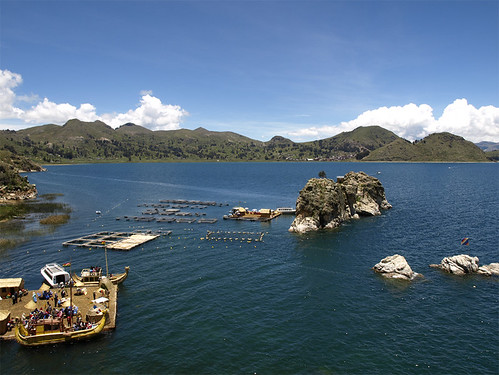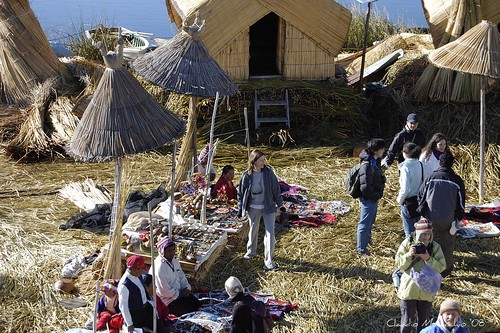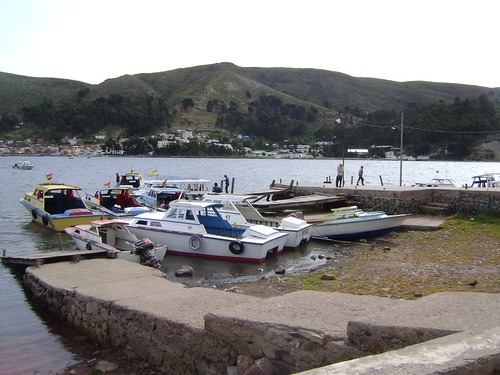
Located at over 3800 feet, Lake Titicaca is the highest navigable lake in the world and one of the legendary places in South America. Heir to ancient traditions and myths, surrounded by mountains and dotted with islands, is an invitation to discover the beauty and mystery of the Bolivian highlands.
A mirror of open water in the highlands, where altitude breath away, keeps the secret of the origin of the Inca empire, the source of a culture that continues to cast its light, after years of darkness, on the civilization that was imposed. Lake Titicaca, in the past revered by the Incas and today considered one of the purest places in the world, is the origin of this rule. That empire was Tahuantinsuyo, who was in this region of Titicaca (now shared between Bolivia and Peru) where natural treasure raising llamas and alpacas, growing quinoa, potato and other agricultural products.
Floating Islands:
Titicaca is worthy of a chapter in the book of records: located over 3800 meters high, is the highest navigable lake in the world, extends over some 8000 square kilometers and has a maximum depth of 280 meters. It is situated only 70 kilometers west of La Paz, from where excursions by the lake, islands and surrounding natural areas. An asphalt road connecting La Paz and Copacabana, next to Lake Titicaca, whose waters of rare transparency are fed by the glaciers of Apolobamba and Real. The surrounding mountains seem very close, but they are actually about 30 miles away, almost invisible for the purity of air, which seems to narrow the gap. Other tourists prefer to visit from Puno, the Peruvian side, or integrated into a larger circuit that part of La Quiaca in Jujuy, passing Villazón (Bolivia), the Salar de Uyuni, Potosi, Sucre, Cochabamba, La Paz and Copacabana.

Whatever the route chosen, Lake Titicaca holds the most beautiful scenery imaginable, with its harmonious water dunks against the giant peaks of the Bolivian Andes, which appear watch snow forever the fates of indigenous islands devoted to their gods. These islands break the surface outcrops are just the same mountain range that surrounds the lake.
Titicaca region can be visited all year round, thanks to a sunny climate moderated by altitude but, refreshing altiplano nights by lowering the temperature significantly. The impact of tourism in the area, also frequently visited by travelers arriving from Peru after Cusco and Machu Picchu tour.
Copacabana and islands:
On the shores of Lake Titicaca stands the town of Copacabana, a tourist and archaeological site famous for its shrine, it was in pre-Columbian times a place of worship and ceremonial astronomical observation. If today is dedicated to the Virgen Morena, the city was the destination of pilgrimages to the Island of the Sun and Moon. The present Catholic church was erected in the central city square in the sixteenth century, and is a little gem shining white domes whose altar glitters with gold and silver. From Copacabana shipped out numerous excursions to the Islands of the Sun and the Moon, or walks to the viewpoints that are nearby, including pre-Columbian archeological sites such as Pitchfork’s Trail (an old observatory), the Kusijata or Intikala. They have some accounts that this city, ancient, takes its name of «Coppa-kcaguaña» or the «path of the stars that leads to God» is that since there is clearly seen that compass pre-Columbian is the Southern Cross.
Copacabana
One of the most interesting places to visit is the Isla del Sol, on Lake Maggiore, where are many vestiges of the cultures Tiawanakota, Aymara and Quechua that inhabited this place since time immemorial, before the Incas: the steps of Yumani (all a challenge for the legs), the palace of Pilkokaina the Chincana the Footsteps of the Sun and the Sacred Rock. Also be reached by boat to the Isla de la Luna, also known as native Koati second holiest site in local indigenous people, and where women are concentrated worship in the form of the Maidens of the Sun.

The lake is another must see places, such as Uros Island, where all the buildings are raised on piles of eucalyptus, and everything is made with flexible stems of cattails, the same floor as they make the typical boats that ply the lake waters and are a symbol of Titicaca. While naturally there are catamarans, hydrofoils and other boats, the «Totoritas» or «little horses of reeds» hold a unique tradition and are the most sought Postal these waters. Well I know the people of Suriqui, so working in construction who were elected by the Norwegian Thor Heyerdahl to build the boat of reeds with which they could prove that these boats were capable of long ocean passages.
On the Island of the Uros people live mainly in the reed handicrafts, hunting and fishing. Local traditions are also skin deep on the Island of Taquile, where several Inca ruins. However, one of its main attractions is that you can spend the night at the people who organize themselves and tourist services are known for their hospitality. Equally interesting is the island of lovers, the most populous of the lake, which also has great archaeological value. Whichever island you visit, where people are moving, trade, talk, bargaining, and the warmth of men and women who populate the highlands is one of the most intimate events that take visitors to these places suitable for condors. When there is a little more time, or particularly interested in ecotourism around the lake are ideal for trekking and mountaineering. Meanwhile, the Mirror Lake Titicaca is jealously guarding its secrets well protected by the double barrier of the height and depth, from the invisible mermaids to hide in the background, the fund that was once thought endless up sunken treasure. .. not to mention an entire city, an Andean Atlantis which states that still shine, submerged, gold and silver of the Incas.
Useful Data:
How come?
You can travel to Lake Titicaca from La Paz, then taking the paved road that leads to Tiquina Strait, after crossing by boat to Copacabana. You can also enter from Argentina by La Quiaca, following the stages described above, or from Lima (Peru), another major resorts around the lake.
Climate:
It should be noted that it is an area of high thermal amplitude, with sunny weather during the day and drop in temperature overnight.
Excursions:
Around Lake Titicaca excursions can be arranged for ecotourism, adventure tourism, mountain climbing and trekking, as well as sailing and visits to the islands
Meals:
A visit to Lake Titicaca is a good opportunity to sample the local cuisine, especially the trout that are caught in the lake water itself, and quinoa-based dishes and other Andean cereals.

Bon Voyage!
Leave a Reply
You must be logged in to post a comment.
Recent Comments